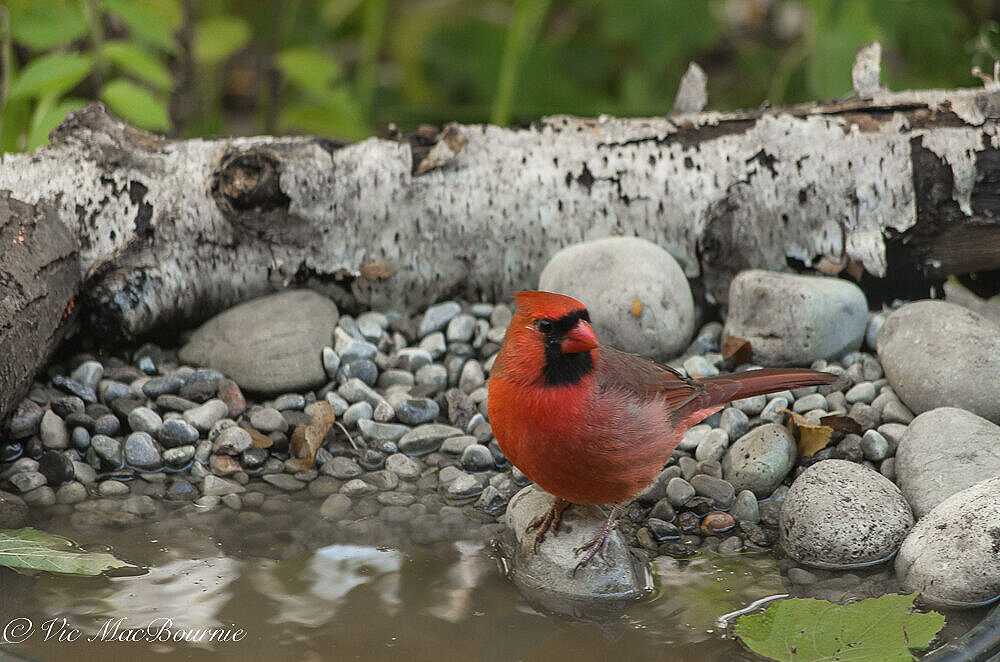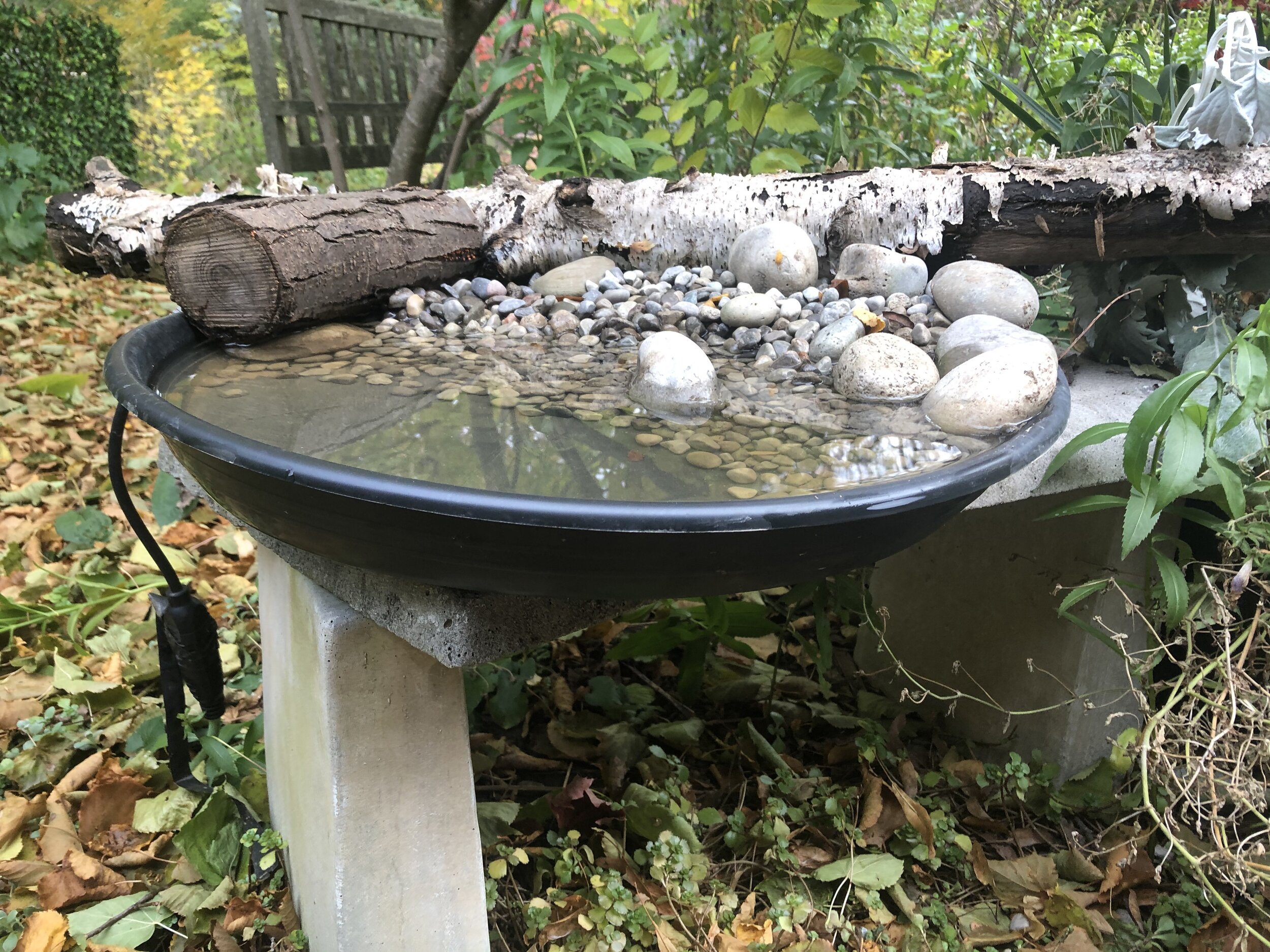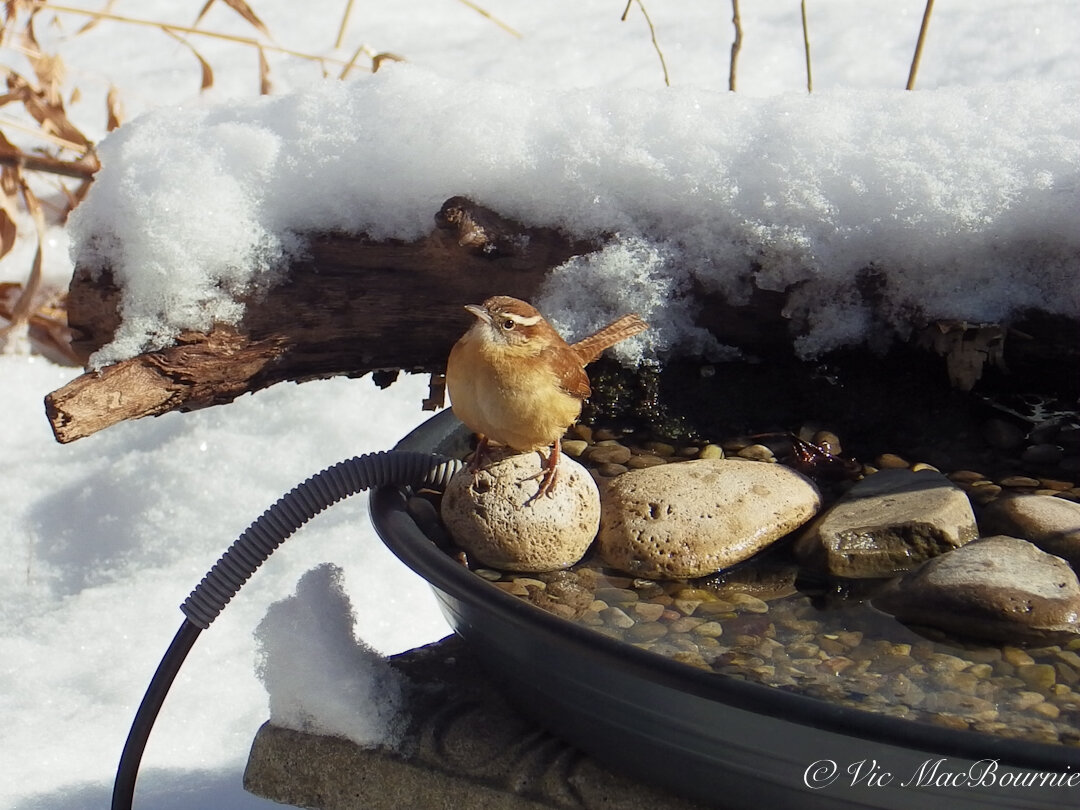Attract birds all winter with DIY heated birdbath
Build a heated birdbath and photo studio for the birds
Winter is a great time to focus on attracting birds to your backyard.
The cold temperatures, often freezing overnight, make it difficult for our backyard birds – especially when it comes to obtaining water. Even those of us who are vigilant about keeping our feeders full, too often underestimate the importance of a reliable water source.
We are lucky enough to live near a small, fast-flowing stream that provides emergency water sources to all our neighbourhood birds. However, I like to make their lives a little easier by ensuring a reliable water source in the garden. Not only does it make their lives a little easier, it attracts a wide variety of birds including many that may not regularly visit the feeders.
For my other posts on bird baths, check out adding water to your garden and a DIY solar drip conversion.
Why water is critical for birds especially in winter
Water is critical to birds in the heat of the summer and even more important in the winter when traditional water sources are frozen over, including ponds and puddles. Bathing is an important part of a bird’s feather maintenance. Wetting the feathers in a bird bath helps to loosen dirt and makes feathers easier to preen. When preening, birds carefully rearrange the feathers and spread oil from the preen gland so they remain waterproof and trap an insulating layer of air underneath to keep them warm. That’s vital in a Southern Ontario winter where temperatures and wind chills can reach a bone chilling -30 C. and beyond and stay that way for days.
A cardinal stops for a drink among the stones in the heated bird bath and outdoor photo studio refection pond.
Birds lack sweat glands, so they traditionally need less water than mammals. They do, however, lose water both through respiration and in their droppings. Many insectivorous birds get most of their water from their food, but seed-eating birds have a dry diet and they need to drink several times a day.
The appeal of a reliable water source may even be a stronger draw to birds than a well-stocked feeder, especially if there is no other reliable water source in the area.
Attract birds to your heated bird bath
The heated bird bath ready for winter.
If you set up your heated bird bath in a separate area to where you normally have your bird bath, or your heated bird bath is entirely new to your garden, don’t be surprised if it takes a while for the birds to discover and be comfortable using it.
To encourage birds to use your heated birdbath be sure to set it up, like any bird bath, in a safe area of the garden. Cover for your birds in case of attack is just as important in winter as it is in the summer.
Include perches above the bird bath to allow the birds to come down and check out the bird bath from a short distance. Include stones or landing spots inside the bird bath where smaller birds can either drink from or wade into the water slowly.
Finally, place a feeder nearby to attract birds and make them feel safe in the area. The combination of food and a reliable water source in winter will certainly encourage them to use the heated bird bath.
Build your own photo studio for the birds
With this in mind, I set about creating both a reliable water source and a backyard photo studio and reflection pond. In fact, I’m in the process of building two: one large reflecting pool and a smaller heated pool that will be the main source of water in the yard when the temperatures turn to freezing.
Let’s first deal with the smaller one. The larger reflection pond will be discussed in a later post.
Our DIY project started with a round, medium-size black plastic basin that I picked up from a local nursery for just over $10.00. It’s a couple inches deep, so it’s perfect for small- and medium-sized birds to use safely. Larger birds, like jays and robins, will not hesitate to create havoc in the bath as they splash about, but we’re all good with their daily antics.
This bird bath is quickly becoming the gathering place for our backyard birds.
It sits on a concrete bench just outside our family room French door where I can easily monitor the water levels. At the same time, it’s close enough that I can use it to capture photographs of our feathered friends enjoying a bath. And, I can do it from the warmth of our family room.
Cute little Carolina Wren taking advantage of the heated bird bath to get water during winter.
An electric heater from Wild Birds Unlimited was carefully placed in the bird bath and hidden with a thick layer of pea gravel and a few larger river rocks to give the birds a landing spot. A birch branch across the back will help to stabilize the bird bath in case a large bird or animal decides to use it as their personal bath tub. It also creates a lovely background for the birds using the feeder. A few other branches help to hide the edge of the plastic tray, give it a little more stability and add to its natural appearance.
The heater, buried in pea gravel, will keep the bird bath ice-free in the coldest temperatures but remain hidden under the gravel. I’m expecting the heated pea gravel to also play a role in helping to keep the water ice-free, but adding a pitcher of hot water on particularly cold mornings will keep the water open. The pea gravel also provides birds with a gradual slope into the water much like a sandy beach. This allows birds of all sizes to enter the water to a comfortable depth, and put them in a position that creates good photographic opportunities.
Although the goal was to create a reflection pond that doubles as a heated bird bath, the round plastic dish comes up a bit short to capture perfect reflections of the birds on a regular basis. It will work nicely for a small bird on the pea gravel, but the reflection will likely fall just short for a larger bird like a blue jay or cardinal. I can certainly live with that, since the real reflection pond will be in another part of the garden.
More on that later. Stay tuned for an historical hack that will form the basis of the larger reflection pond. You won’t want to miss that.



